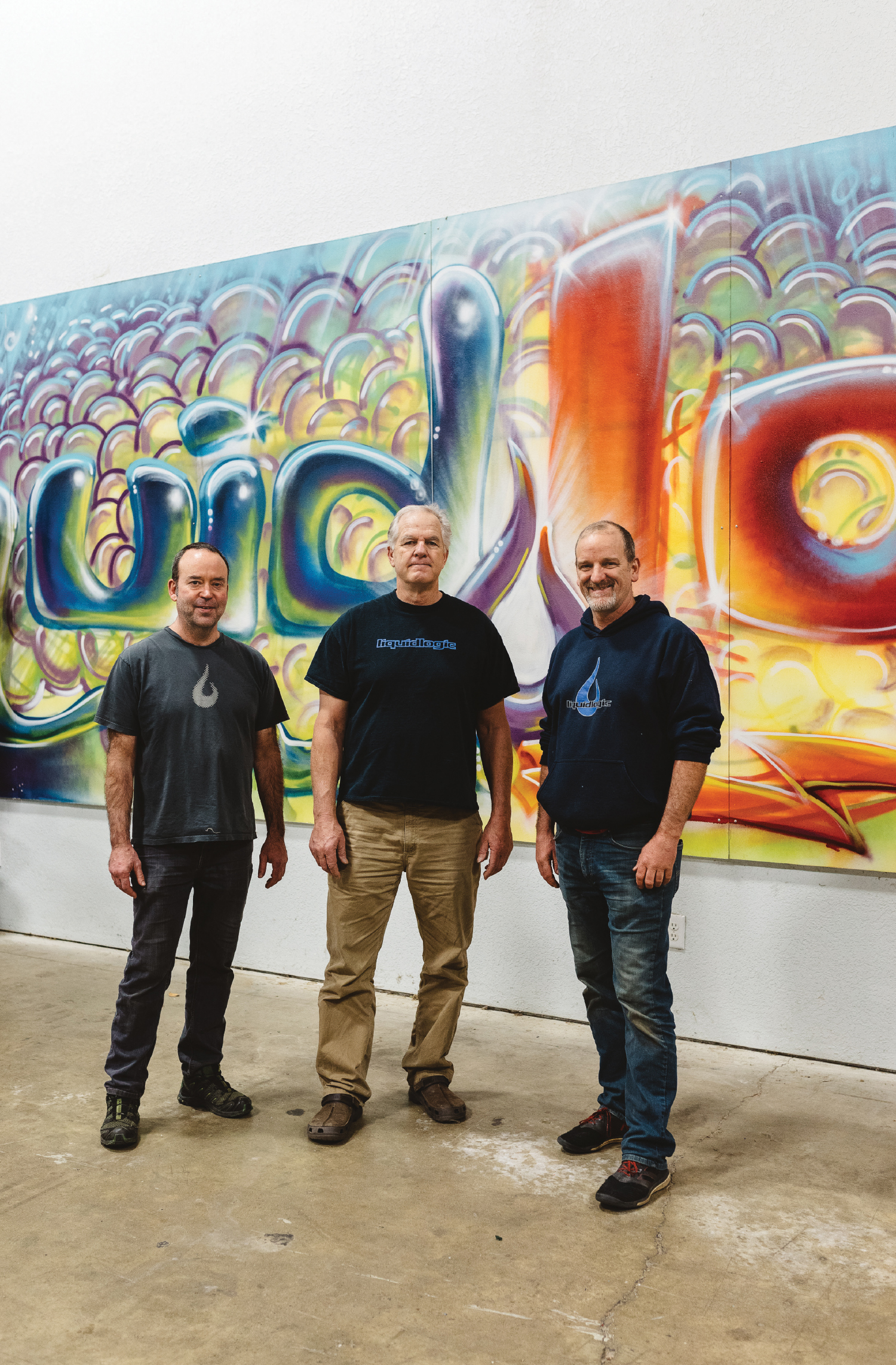By: Kay West

Testing the Waters
(L-R) Bryon Phillips, Woody Calloway, and Shane Benedict pause in a landlocked moment at Liquidlogic’s construction facility in Fletcher. All three were key in growing the kayak company.
Photo by Rachel Pressley
The Session, a well-traveled blue kayak, leans against a wall in the open office where Shane Benedict, co-founder of Liquidlogic, spends some of his executive time. The freestyle kayak was one of the first made in 2000, when a core crew of passionate paddlers broke off from the kayak company where they all met and teamed up on an entrepreneurial mission. “The company was bought by a venture capital group,” says Benedict. “They stopped caring about things we cared about. We wanted to focus on making good kayaks.”
The Session was created in a mountain cabin by Benedict and Bryon Phillips; Allen Stancil worked on their first recreational kayak, the Saluda; Woody Calloway and Steve Jordan developed sales resources, and Tom Dempsey found a manufacturer for their boats. Liquidlogic was born.

Paddler Stephen McGrady takes a Liquidlogic kayak down a waterfall in the Callahan River in British Columbia.
Photo by Toby McDermott
“We did the design, marketing, and sales, and production was in Pennsylvania,” explains Benedict. “But when someone else is making your stuff, there’s a percentage of the sales margin you’re not getting.”
In 2007, Liquidlogic merged with Native Watercraft, a kayak fishing brand with a manufacturing facility in Greensboro, North Carolina, and began making LL kayaks there. “We were able to hire more people, and most of them are paddlers.”
But the mountains, and particularly Polk County’s Green River — a whitewater hub that includes class IV and V rapids — called them back home. “We started Liquidlogic in this area because we wanted to paddle the Green River. We wanted to be back here, to be in the mountains, near the river.”

By testing out products and giving feedback about design, paddler Erin Savage is helping grow the women’s kayak community.
Photo by Rachel Pressley
A grocery-distribution warehouse happened to be available in Fletcher, so after extensive upfitting and renovations, Liquidlogic and Native Watercraft moved operations to the 130,000-square-foot building which houses offices, an R&D (research and development) studio, warehousing, and manufacturing for all Liquidlogic kayaks and Native Watercraft fishing kayaks — about 50 different models in all.
A tour of operations — available to the public once a month — begins on the manufacturing side, starting at bins of powdered plastic in dozens of colors, weighed out in buckets according to which model is being made, then poured into the bottom of that model’s mold. Production moves step-by-step across the floor — mold to crane to oven to cooling frame to pre-rigger to assembler for the finish with handles, seats, and other hardware. “Most of the parts and pieces for our kayaks are made in-house or in North Carolina. We try to keep it local.”

Pat Keller, part of the Research & Development team at the Fletcher factory, helps shape the next big boat.
Photo by Rachel Pressley
Finished kayaks are placed in fabric sacks, then moved to the warehouse side of the building. “It’s like farming. We grow the crop all winter until we’re bursting at the seams, then we start selling in the spring and they go like crazy.” Between 10,000 and 12,000 kayaks are produced every year.
Their destination is retail outlets and customers all over the world, as well as paddlers such as Erin Savage, a program manager for Appalachian Voices and member of Team LL. The Washington State native came to Asheville after graduate school in the Northeast, attracted by the area’s year-round kayaking. A team member is an ambassador for the brand and a resource for R&D. “We paddle their boats, provide media content, and participate in events,” she explains. “I volunteer at a lot of women’s events to help grow the women’s kayak community.”

A warehouse full of inventory.
Photo by Rachel Pressley
Last summer, she and fellow team member Genevieve Royer paddled the Delta V prototype and offered feedback to the design team. “When they came out with the final model last year, they had fixed things we said should be addressed. They took a good design and made it better, and I was excited they came out with a really good high-performance creek boat for smaller people like me.”
On November 2, she’ll join close to 200 other high-performance paddlers for the 24th annual Green River Race, a thrilling half-mile timed race through the main section of the notorious Green River Narrows, where the gradient drops more than 100 feet per mile. “That event is all about the speed,” says Benedict.

Mayra Trujillo sews brand accessories.
Photo by Rachel Pressley
But the Green River Spring Cleaning is all about slowing down and cleaning up. Started by Benedict and now organized in partnership with MountainTrue, the 9th annual event takes place this month, with the goal of covering all 30 miles from the Upper Green at the top to Lake Adger at the bottom.
For Benedict, it’s also all about the love. “I have kayaked all over the world,” he says. “But the best place, my favorite place, is here.”
The Green River Spring Cleaning paddling event, co-sponsored by Liquidlogic and open to all skill levels, happens Saturday, April 13, 10am-5pm, with an after party at The Gorge Zipline. For more information, call 828-692-0385, e-mail gray@mountaintrue.org, or go to mountaintrue.org/event/green-river-spring-cleaning. For more information about Liquidlogic and Native Watercraft, see liquidlogickayaks.com.
